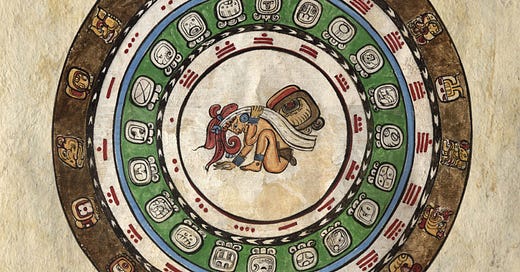Scientists Think They've Finally Cracked How A Confounding Mayan Calendar Works
The Maya sure were incredibly talented astronomers
Hiya!
Like many people, the ancient Maya civilization fascinates me. Beyond their expansive populations, ingenuity, advanced irrigation systems, complex trade networks, sports, warfare, and sophisticated writing still amaze and confound us. Based on what experts have learned about them so far, the ancient Maya seem very modern for an ancient civilization.
Still, perhaps the most curious of the Maya inventions is the notorious Maya Calendar, which we’re still figuring out. However, a pair of anthropologists cracked one aspect that has perplexed brilliant minds for years.
Maya Calendar
I had heard of the Maya Calendar and knew it befuddled experts while also leaving them in awe, but I never spent much time learning about how it works. I suppose I thought if it was too complicated for experts, it was likely too confusing for me to understand. How wrong I was.
The calendar remains elusive in many ways, but researchers have learned a decent amount about it — and while it is a bit complex, it’s easy enough to understand.
Simply put, the Maya Calendar consists of at least three dating systems that form two calendars, which work simultaneously as one mega calendar. Okay, maybe not so simple. Let me explain.
There is a civil dating system called the Haab, which has an 18-month period of 20 days each and five extra days, totaling 365 days before the cycle starts over. Another dating system — called the Tzolk’in, or sacred calendar — has 260 days, divided into three groups, but totaling 13 months of 20 days.
These two dating systems, the Haab and the Tzolkin, work together like interlocking gears in a clock to create the Calendar Round. The Haab system reflected the Sun’s cycle, and the 260-day Tzolkin system recorded the movements of the Sun, Moon, and planets. When used simultaneously, the two systems align every 52 years.
The third dating system is astrological and forms the other major Maya calendar called the Long Count Calendar, which has a cycle of over 5,000 years. This is the calendar cycle that created all of the apocalypse hullabaloo back in 2012 because the last cycle started on August 11, 3114 BCE, and finished on December 21, 2012 CE.
I was 25 years old and remember the conspiracy theories well. People thought the end of the cycle meant the end of the world. Remember the movie literally titled 2012? But clearly, the world didn’t end because here we are.
In actuality, 2012 marked the ending of a larger cycle the Maya tracked called B’ak’tun, which encompasses thirteen 400-year periods.
So far, nothing in known Maya writing indicates they had any predictions about what might or might not occur when the cycle ends. But a retired archaeologist and Maya expert at Longwood University, Walter Witschey, pointed out:
“The Maya had several rarely used units that were even larger than b’ak'tuns, giving them the capacity to count millions of years into the future.”
Considering this, it seems unlikely the Maya thought an apocalyptic ending would occur at the end of 2012. Regardless, all of this is a decent amount of information regarding the Maya Calendar, but it doesn’t include all aspects of it.
There’s another dating system consisting of 819 days, which has confounded experts, but recently, a pair of researchers finally cracked it by viewing it from a different perspective.
Keep reading with a 7-day free trial
Subscribe to Curious Adventure to keep reading this post and get 7 days of free access to the full post archives.



